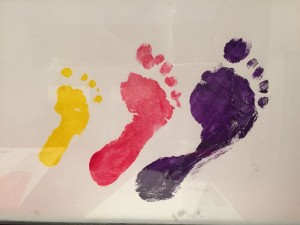Our last day of treating patients is Friday 20th December, 2024 and we will reopen on Monday 6th January, 2025
The Podiatrists will be unable to return calls during this period, but will endeavour to reply upon their return to work.


Our last day of treating patients is Friday 20th December, 2024 and we will reopen on Monday 6th January, 2025
The Podiatrists will be unable to return calls during this period, but will endeavour to reply upon their return to work.

A Big welcome to our new Podiatrist Jhin!
Jhin has many years of experience and we are so excited to have her working with us on Mondays until 6pm.
If you’d like to make an appointment with Jhin please click below.
Make an appointmentWe wish you a Happy Easter and hope you enjoy the break.
Good Friday: Closed
Easter Saturday: Closed
Easter Sunday: Closed
Easter Monday: Closed
If you wish to make an appointment over the weekend, you can book online here.
With the few little glimpses of good weather we had last week, many of us are contemplating sandals and exposing our toes!
If your toes are unsightly from the following issues he Keryflex nail restoration system may be appropriate for you:
The system allows your podiatrist to remodel nails affected by fungus, nail dystrophies and trauma using a special resin which creates a flexible, non-porous nail which is unaffected by detergents, nail polish and acetone.
If you wish to learn more, make an appointment!
A few days ago, I had to teach my 6 year old son to tie his shoelaces thanks to a new pair of running shoes. After several attempts at the single loop and rabbit ears method, we stumbled upon this little gem! It is super easy to learn (although can cause a knot when untying).
See the video below (starring the 6 year-old to prove how easy it is!):
It is important that Diabetic monitor their blood sugar levels regularly, maintain an active lifestyle and healthy diet, but also, that they take care of their foot health!
People who have diabetes have a much higher chance of developing Neuropathy and vascular conditions, which affect the sensation in the feet and the ability to heal any wounds, which may occur. As a result it is important for Diabetics to follow a few guidelines to take care of their feet.
DAILY FOOT CHECK
WHAT TO AVOID
Pregnancy takes a big toll on our bodies and can be quite uncomfortable for many women. Whilst some women have no trouble with their feet at all, many have pain and discomfort. Generally the pain resolves shortly after the baby arrives, but in some cases, the changes are long term. Here are a few issues you may have with your feet and some  ways to alleviate some of the discomfort:
ways to alleviate some of the discomfort:
Sore Heels/Arches: With the additional weight of your baby, fluid and the placenta, a lot of extra load is placed on the feet. This extra load, coupled with the relaxin hormone, released in pregnancy can result in the muscles and ligaments supporting the arch of the foot to stretch and reduce the arch height resulting in a flat foot. Flat feet or excessive pronation (rolling in) can result in foot, leg and hip pain
Treatment: To prevent pain, there are a number of things you can do
Shoe size changes: There are many reasons that a pregnant woman’s shoe size can increase- Swelling of the feet, the effects of relaxin, extra load- but it is important to ensure that you accommodate the larger foot to avoid painful skin changes (corns and calluses), ingrown toenails or toenail thickening.
Swelling: There are number of reasons that a pregnant woman’s feet may swell and these are best discussed with your obstetrician. They may suggest compression stockings and elevating the feet whenever possible.
Callous and Corns: For the reasons listed above (extra weight, swelling etc), the foot may fit differently into shoes and take more pressure during walking. As a result to protect underlying vessels and nerves, the body will create thicker skin in the areas at risk. This thickening of the skin may become painful and your podiatrist can remove this for you.
Given today is the coldest day of the year so far, I thought it was a good time to talk about Chilblains.
Chilblains present on the feet as patches of red, inflamed lumps on the skin that are often itchy or painful. Whilst you can get one chilblain at a time, it is more common to see several appear at once. Chilblains are caused by frequent and repeated exposure to cold then heat. This is because the blood vessels in the feet constrict (get smaller) in the cold and when exposed to heat very quickly, a rush of blood to the vessels can result blood leaking into the surrounding tissue causing a chilblain.
Symptoms
Treatment
Who is most at Risk?
Chilblains can affect the heathy general population, however are more common in children and the elderly.
Patients with existing Circulation problems such as Diabetes and Raynaud’s Syndrome and smokers are most at risk.
Patients with Diabetes who develop Chilblains should see their podiatrist for treatment to ensure the Chilblain does not become ulcerated.
Tips to Avoid Chilblains
It’s Back to School Time and for many parents, a time to buy new school shoes.
Here’s a few tips for making sure you buy the right shoes for your child:
Which Shoes did my son start Prep with last week? The Ascent Junior…. It looks like a normal school shoe, but has the sole of a sports shoe and is endorsed by the Australian Podiatry Council. It also comes in half sizes which was a big plus for us given my son is halfway between 2 sizes.
If unsure, feel free to email us for advise or come into the rooms at the Epworth in Richmond. Call 9421 4116 or Book online
We received another lovely review from a patient this week! Click here to read it and like us on facebook too if you are feeling generous!
It’s always lovely to hear that we are making people feel better and getting them back on their feet!